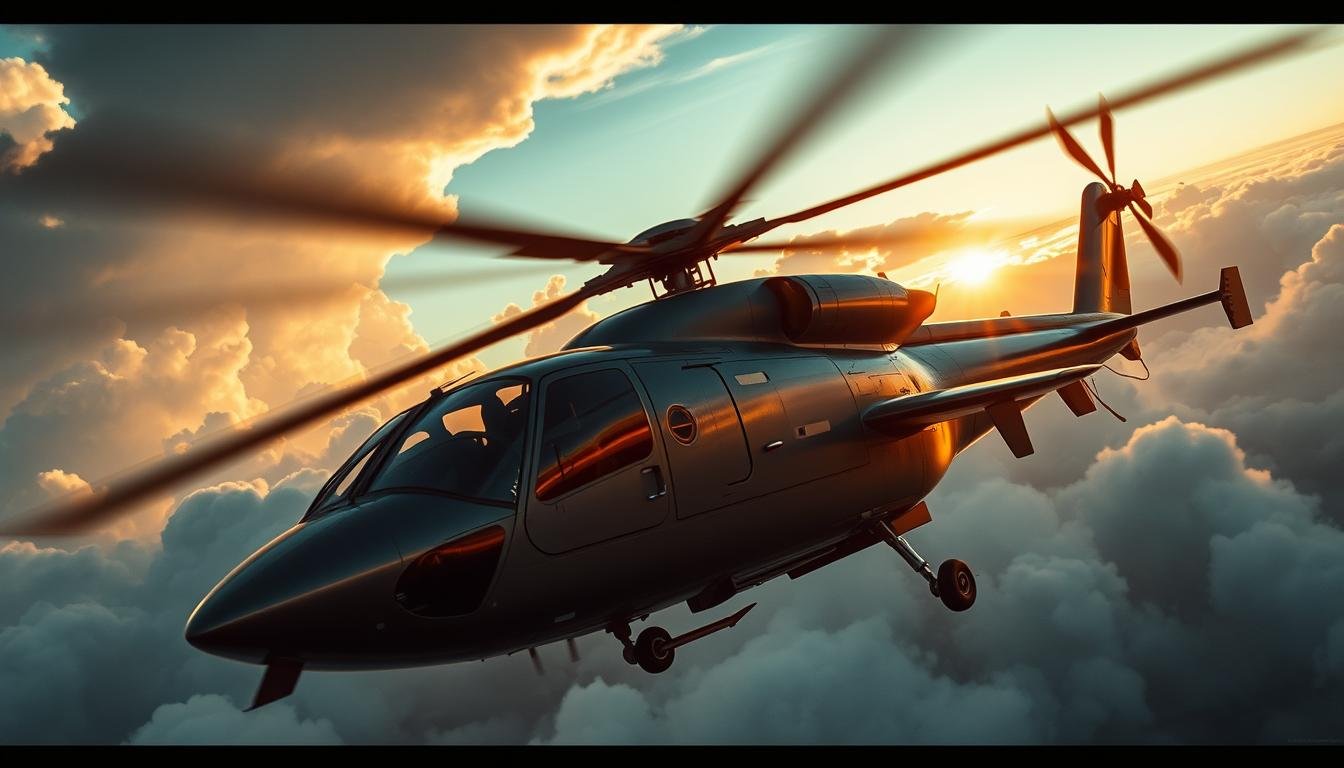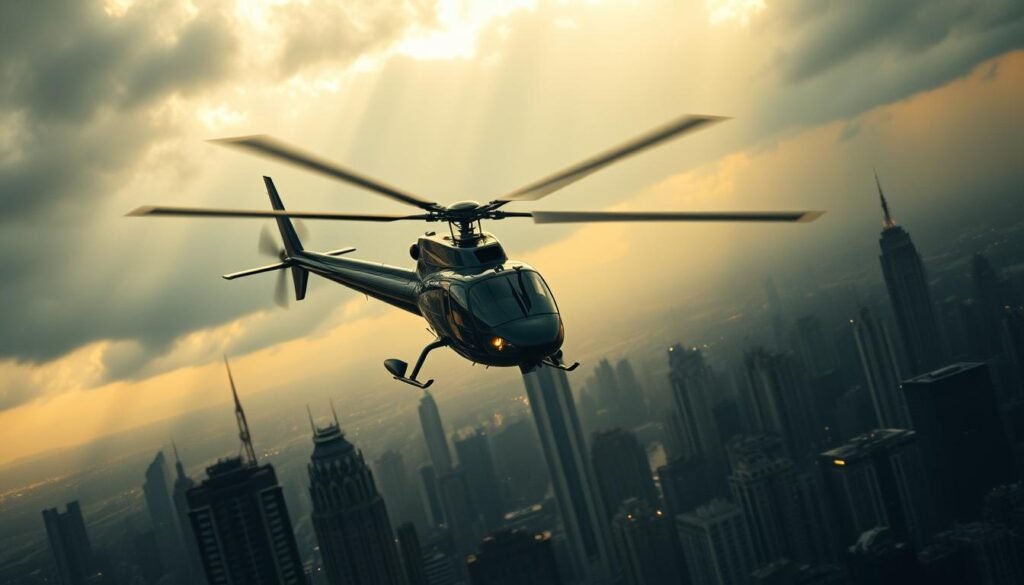Helicopters in movies have powered some of cinema’s most unforgettable action set pieces. What makes a rotorcraft moment feel authentic and why do audiences forgive wild physics for the sake of spectacle?
From Apocalypse Now’s Ride of the Valkyries to Mission: Impossible – Fallout, filmmakers have used aerial craft to raise stakes and create lasting images.
These sequences blend aerial choreography, stunt work, and VFX. Practical effects often make the difference between a thrilling moment and a forgettable shot.
Readers will find analysis that compares realism and fantasy, with examples like Spectre’s barrel roll, Live Free or Die Hard’s tunnel impact, Blue Thunder’s LA River chase, and Black Hawk Down’s combat realism.
For deeper context on accuracy versus spectacle, see a detailed look at portrayal and realism here, and a curated list of iconic scenes that shaped modern action cinema.
Key Takeaways
- Rotorcraft set pieces often act as narrative turning points that heighten stakes.
- Practical stunts plus selective VFX make scenes feel tactile and real.
- Cinematic examples span war films, spy thrillers, and urban action.
- Audiences accept some implausibility when a sequence delivers strong visuals and tension.
- The silhouette and sound of a hovering craft prime viewers for memorable moments.
Helicopters In Movies: Iconic Scenes That Define Realism And Spectacle
A single airborne sequence can redefine a film’s stakes and lodge an image in viewers’ minds. Directors lean on sound, scale, and daring staging to make these moments stick.
From “Apocalypse Now” To “Mission: Impossible” — How Helicopter Scenes Became Must‑Watch Moments
Apocalypse Now set a high bar with its napalm assault scored to Wagner. That audacious choice fused music and rotor thunder into a cultural touchstone.
Other standouts staged practical danger: the tunnel tethering in Mission: Impossible and Blue Thunder’s LA chases. These beats read clearly on screen and still fuel discussions about craft and risk.
Why “Helicopter Scenes” Stick: Sound, Scale, And Sky‑High Stakes
Sound design gives the whoomph that primes adrenaline. Visual scale — cockpit POVs, rooftop drops, and narrow corridors — sells danger fast.
Police craft add authority, especially when cables and high‑rise geography make a building breach or window strike feel imminent.
The Listicle Approach: Grouping By Realism, Fiction, And Cultural Impact
- Grounded: physics‑aware set pieces that honor real aerodynamics.
- Flourish: over‑the‑top sequences that favor spectacle over plausibility.
- Cultural: moments that spawn quotes, memes, and repeat viewings.
For a curated rundown of iconic helicopter scenes, see this iconic helicopter scenes. To explore a broader watchlist, check this must-watch helicopter movies.
Realistic Portrayals: Craft, Physics, And Plausible Stunts In Helicopter Scenes
Filmmakers who favor authenticity build aerial sequences around real aircraft behavior and pilot technique. Small choices—airframe, radio chatter, formation spacing—create a feeling of procedure and risk that audiences accept.

“Apocalypse Now” — Military Tactics, Hueys, And Cinematic Authenticity
Apocalypse Now staged coordinated assault flights with Bell UH‑1 Hueys and OH‑6 Loach aircraft. The use of period tactics and the “Ride of the Valkyries” motif added war texture and aural weight.
“Mission: Impossible – Fallout” — Tom Cruise’s Real Piloting Elevates The Sequence
Fallout used EC145/H145 and H125 models and trained its lead to pilot for real aerial camera work. That choice keeps the action anchored to true aerodynamics and precise maneuvering.
“Black Hawk Down” — Tail‑Rotor Failure And Combat Realism
The film depicts an RPG strike severing an MH‑60L tail rotor, causing loss of anti‑torque and an uncontrolled spin. This aligns with documented combat damage and emergency handling.
“Blue Thunder” — Police Surveillance, Urban Flying, And Los Angeles Skyscraper Chases
Blue Thunder relied on modified Gazelles and JetRangers to stage urban surveillance runs. Filming on Los Angeles streets turned infrastructure into realistic obstacles that shaped every turn.
| Film | Aircraft | Realism Focus | Key Element |
|---|---|---|---|
| Apocalypse Now | Bell UH‑1, OH‑6 | Formation tactics | War sound design |
| Mission: Impossible – Fallout | EC145, H125 | Pilot‑performed stunts | In‑camera aerials |
| Black Hawk Down | MH‑60L | Combat failures | Tail‑rotor strike |
| Blue Thunder | Gazelle, JetRanger | Urban surveillance | LA geography |
“The most convincing scenes show machines with limits, solved by pilot skill,”
Summary: Careful aircraft choice, trained crews, and grounded staging let action feel both cinematic and plausible. Realism rewards detail.
Fiction Turned Up To Eleven: Over‑The‑Top Helicopter Explosions And Impossible Escapes
Some film sequences crank spectacle to eleven, turning ordinary urban gear into outrageous aerial set pieces.
Live Free Or Die Hard stages a bold tunnel ambush where John McClane redirects traffic and launches a police car into a hovering Eurocopter AS350 B2. The car‑into‑aircraft moment reframes a confined tunnel as a physics‑defying payoff and stays lodged in viewers’ minds.
“Live Free Or Die Hard” — Launching A Car Into A Chopper In A Tunnel Set Piece
Die Hard fans cite that car launch as pure stuntcraft: tight editing, roaring rotors, and a single window of escape sell the gag.
From “Rambo III” To “Spectre” And “Tomorrow Never Dies” — Outrageous Maneuvers, Fireballs, And Flair
- Rambo III piles variety: crash landings, an explosive‑tipped arrow, and a tank vs. rotorcraft finale that maximizes spectacle per scene.
- Spectre opens with a Bo 105 barrel roll above a crowd, pushing aerobatic credibility for a franchise‑level splash.
- Tomorrow Never Dies freezes time with a motorcycle leap over a descending AS355, a concise money shot of stunt design.
Other flicks riff on the idea: motorbikes hurled into a hovering chopper or a grenade‑stuffed football that ends in a giant explosion. Editors and stunt teams trade realism for thrills and, for many viewers, the trade is worth the ticket.
Audience Impact: How Helicopter Scenes Shape Thrills, Memes, And Movie Memory
When a rotorcraft appears on screen, viewers brace: the mix of noise, motion, and risk primes instinctive attention.

Adrenaline And Audio: Rotors, “Ride Of The Valkyries,” And Edge‑Of‑Seat Tension
Sound drives fear and awe. Rotor slap, turbine whine, and a tense score can spike heart rate fast.
Apocalypse Now used Wagner to turn approach into ritual. That scoring choice shows how audio can make an arrival feel like an attack.
Pop Quotables: “Get To Da Choppa!” And Franchise‑Defining Moments
Short lines hardwire scenes into culture. Arnold Schwarzenegger’s “Get to da choppa!” keeps resurfacing as a shorthand for escape.
“I love the smell of napalm in the morning.”
Spectacle Economics: Why Filmmakers Keep Returning To Choppers For Big‑Screen Payoffs
Producers rely on aerial beats because they make trailer‑friendly highlight reels. A downed police craft between towers, a rotor disk slicing through a horde, or a rooftop rescue compresses action into a single shareable shot.
- Wide air shots cut to cockpit close‑ups to keep orientation clear.
- Windows and rooftops frame instant suspense that reads on every screen.
- Cross‑genre use—war, crime, horror, spy—keeps helicopter movies bankable over time.
Conclusion
A well‑staged sequence lets a chopper carry plot, character, and tension at once.
From Apocalypse Now’s tactical Hueys to Live Free Or Die Hard’s tunnel stunt, Spectre’s barrel roll, and Mission: Impossible – Fallout’s Cruise‑piloted chase, the best set pieces blend craft and spectacle.
Audiences recall rotor rhythm and silhouette first, then plot details later. The most enduring helicopter scenes pair practical air work with tight editing so a sequence feels immediate and rewatchable.
Expect franchises and filmmakers to keep mixing realism with bold excess. For a focused list of dramatic wreckage and chopper mayhem, see this exploding helicopter films.
FAQ
What makes on‑screen chopper scenes feel authentic versus purely cinematic?
Authenticity comes from accurate rotor sound design, realistic flight physics, and attention to operational detail like crew procedures and instrument displays. Films that consult military advisers or hire real pilots tend to show believable maneuvers, while those prioritizing spectacle will bend rules for dramatic effect.
Which films set the standard for realistic aerial sequences?
Titles often cited for realism include Apocalypse Now for its military choreography, Black Hawk Down for combat fidelity, and Mission: Impossible – Fallout for Tom Cruise’s use of real flying to ground the action. These productions combined technical advisors, authentic aircraft, and careful camera work.
How do filmmakers balance safety and spectacle in dangerous set pieces?
Directors rely on stunt coordinators, experienced pilots, extensive rehearsals, and practical effects paired with visual effects. Pilots perform certified maneuvers, rigs protect actors, and CGI fills gaps. Insurance and regulatory oversight also shape what is possible on set.
Why are chopper explosions and impossible escapes so common in action franchises?
Aerial destruction delivers high stakes and visual payoff. Franchises use over‑the‑top helicopter moments to escalate tension, create memorable heroics, and boost box‑office appeal. These scenes sell spectacle even when they stretch credibility.
Do soundtracks and rotor noise influence audience perception of danger?
Yes. Deep rotor bass, mixed cockpit cues, and dramatic music—sometimes classical pieces—intensify urgency and perceived risk. Sound design often does more to heighten emotion than the visuals alone.
How have specific chopper scenes affected pop culture and quotable lines?
Iconic sequences generate memes, catchphrases, and long‑lasting franchise identity. Memorable calls to action and bold rescues enter popular vernacular and help films remain culturally relevant beyond their release.
Are police and surveillance aircraft portrayed accurately in urban thrillers?
Some films, like Blue Thunder, researched law enforcement aviation and captured surveillance tactics and urban flight profiles. Others simplify capabilities or exaggerate performance to fit plot needs, so accuracy varies by production.
What role do visual effects play compared to practical flying today?
VFX now complements practical stunts, enabling safe portrayals of extreme crashes or impossible camera angles. Many modern productions blend real aerial footage with digital augmentation to preserve realism while avoiding risk.
How do filmmakers depict military tactics and rotorcraft types authentically?
Authentic depiction requires research into unit organization, call signs, and aircraft roles—such as distinguishing utility helicopters from attack variants. Collaborating with military advisors and using correct models helps keep portrayals credible.
Why do audiences respond strongly to tunnel, rooftop, or car‑to‑chopper sequences?
Confined spaces and cross‑platform interactions increase perceived danger and technical daring. Sequences that place characters between vehicles and aircraft create immediate tension and memorable visual set pieces that linger long after viewing.versatile machines have real-world limitations that make their portrayal in movies a mix of both realism and fiction, reminding us that the line between entertainment and reality is often blurred for the sake of a great story.
Related Articles
- The Most Expensive Helicopters in Film Productions
- Helicopter Pilots as Heroes: Celebrating On-Screen Aviation Heroes
- Behind the Scenes: How Helicopter Stunts Are Filmed in Blockbusters
- Helicopters and Superheroes: From Rescue Missions to Epic Battles
- Realism vs. Fiction: How Helicopters Are Portrayed in Movies


